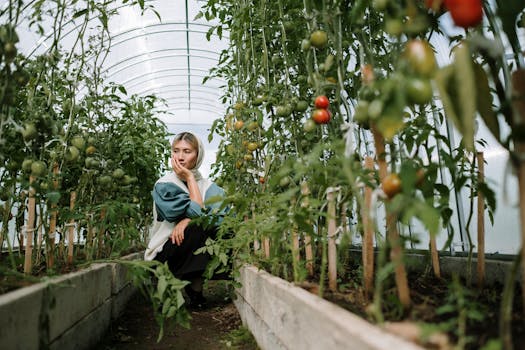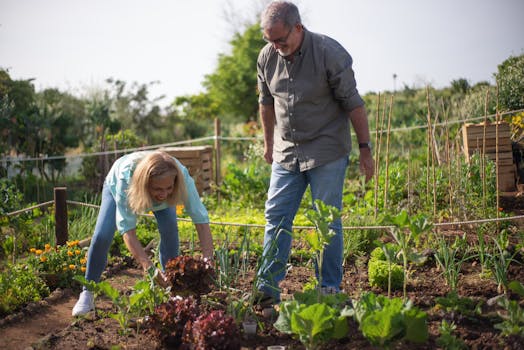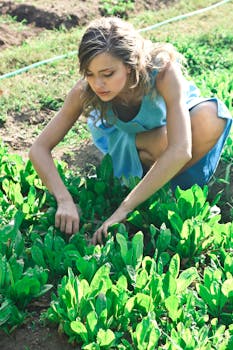In this excerpt from The Urban Farmer, courtesy of New Society Publishers, Curtis Stone offers an innovative approach to urban backyard farming for profit — one that doesn’t require starting with acres of land in the country. In these urban farming business plans, which are based on his own experience and which have been refined over years, Stone outlines how you can start a gardening business while still working a 9-to-5 job, and increase your commitment and profits over time.
All the urban farming business plan models I’m proposing are designed to be scalable. You can start as a part-time farmer in your own backyard (Model 1), and then, after you gain some experience and feel comfortable quitting your day job to pursue farming full-time, you can scale up to 1⁄10 acre (Model 2) or 1⁄4 acre (Model 3). From there, you can continue to scale up as you see fit.
A quarter acre of land or less is the right amount to start with if you don’t have any previous experience in farming. I want to reiterate the lesson I should have learned after my first year: Don’t take on too much! Start small and grow slowly. On 1⁄4 acre, you have the potential to make $50,000 from the land itself, but if you incorporate some greenhouse or indoor microgreens, you could considerably increase that number — all by selling vegetables. This will all depend on your market streams. Understanding your market will be the key to your success in urban backyard farming.
Start-up costs. In order to spend less money as you start your gardening business, you’ll need to spend more time looking for deals on your major investments. If you can give yourself six months prior to starting, like I did, that should be enough time to build the infrastructure you need, prep some land, and look for the best deals on good used equipment. Using websites such as Craigslist, I found a lot of great deals, but I sometimes had to drive for hours to pick an item up. It was all worth it, though. I purchased a BCS tiller with three implements for $1,000, and I bought my first walk-in cooler for $1,000. If I had bought both of those items new, I would have spent $8,000 more. Be sure to shop around. Also, use Craigslist or other websites to post what you’re looking for — I found my BCS because of a post I published. The $7,000 I spent in my first season covered all of my major investments as well as seeds, tools, irrigation equipment, and fertilizer.
Revenue sources. To achieve ambitious revenue from 1⁄4 acre or less, you’ll need access to high-end restaurants and good farmers markets. Specialize in the crops that give you the highest return on the smallest amount of land in the least amount of turnover time. Your trade-off will be less diversity in crop selection. I wouldn’t consider operating a community-supported agriculture (CSA) program at first, as they’re best suited to 1⁄2 acre or more (Model 4).
The advantage of selling vegetables to restaurant markets is that you can grow large quantities of vegetables that have high margins. For example, I grow a lot of baby root vegetables, such as radishes, because some of my customers will go through 100 bunches per week. I grow them almost exclusively for restaurants. I can sell up to 200 pounds per week to all of my clients, but there’s no way I could sell that much at a market, or even in a CSA program; I’m lucky to sell 20 bunches on a good market day.
As you switch your focus to backyard farming for profit, you’ll learn over time what sells and where. Some items (such as Swiss chard and kale) sell better at the market than at restaurants. Learning which products do best in each area takes a little time, so track sales by customer and location in spreadsheets, continuously update them, and leverage this information over time for effective production and sales.
Basic planting strategies. On my farm, I’ve created two categories, Hi-Rotation (HR) and Bi-Rotation (BR), in which I organize all my land. HR areas are plots with constant activity. In them, I plant quick crops which mature in under 60 days, and turn them over four times or more. I don’t plan where all my quick crops will go — I simply decide which areas will be HR, and I leave the details of my weekly planting to the demands of the market. If I don’t sell it, I don’t grow it. I plant BR beds only twice during the growing season. In these, I plant a steady crop which matures in 60 days or more. For commercial urban farming, I don’t recommend growing crops with long dates to maturity, such as onions, potatoes, winter squash, melons, garlic, or corn.
Urban Farming Business Plan, Model 1
In this model, you can earn $21,600 as an urban backyard farmer. At first, you can keep your day job for a year or two, scale your hours back a little bit, and run a farm on a part-time basis. That way, you can give yourself some comfort and security knowing that you don’t have to go in head-first. I will say, though, that jumping in will make you learn faster because you’ll have a lot more skin in the game. But not everyone is willing to take a risk that big at first.
Setup and most profitable vegetables to grow. One-tenth of an acre — about 36 beds at 30 inches by 25 feet on one piece of property — would be a manageable size for this model. Ideally, your own front yard and backyard, or somewhere really close to home, would be your farm. If you were to run this farm with all HR beds growing quick crops, it could gross $28,800 in a 30-week season. But, I would recommend diversifying your farm to give yourself experience with growing a variety of different crops. Thirty-six beds at half BR and half HR could still generate $21,600 in a 30-week season. The outcome for this model is less about maximizing profit and more about learning systems so you can scale up later.
Customers. Focus on market streams that are less risky and take less customer-service time — that’s primarily farmers markets. Most markets run on weekends, so even with a Monday-to-Friday job, you can do a lot of work on the weekends and evenings and successfully operate this model. It might be possible to sell vegetables to restaurants a little bit, as long as you focus on small owner-operator types that you’re confident you could supply. Look for places that will use small amounts, such as an order of $60 per week. Also, make sure they can be flexible with what they get because when you’re learning, you’ll find things may be a little inconsistent. The challenge when selling vegetables to chefs is that they require more customer service. Text messages and phone calls midweek will be common, and if you’re not available for those, you’ll have more difficulty engaging with those customers.
Time commitment. Realistically, you’ll eventually have to scale back your hours at your main job. For example, you could work Monday through Wednesday from 9 to 5, and then work an hour or two in the evenings or early mornings before your 9-to-5 job. On Thursday, you could work 12 to 5 so you’d have time in the morning to harvest for market. You’ll need to have Fridays off almost entirely because if you plan to sell at a Saturday market, you’ll need Friday to process and package all of your products.
I’ve seen small families with children and couples make this type of farm work quite well. The more collective support you have, the more options you’ll have for when the farm work can get done. You’ll need to be able to commit at least 20 hours per week plus a half day selling vegetables at a farmers market in order to make this model work.
Urban Farming Business Plan Model 2: Earn $58,800 on 1⁄10 Acre
Farming on 1⁄10 acre could include running an urban backyard farming business at your own home in the suburbs or on an urban lot. If you have a front and backyard that are a total of 4,356 square feet, you might have enough land to run a farming business from home. With this model, in order to maximize profits, you must only focus on HR beds growing quick crops — that means growing only fast-maturing crops such as greens, radishes, turnips, and some herbs, and turning those beds over at least four times during the season.
Setup and most profitable crops to grow. With a farm this size, you’d have about 36 total beds (as in Model 1) and about 10 inches for the walkways. If all those beds were in HR, your income potential for a 30-week season would be $28,800 from just the field crops alone. This number could rise with greenhouses for the field crops and microgreens. If you produce and sell 50 flats of microgreens per week at $20 per flat, it would be possible to gross $58,800 from a lot this size. Also, if your season is more than 30 weeks (which is the average for North America), your possibilities will be greater.
I recommend growing arugula, cilantro, baby dill, salad turnips, baby lettuce, mustard greens, radishes, baby red Russian kale, and baby spinach. You can mix together all the greens I mentioned (except spinach) in a variety of salad mixes, and you can sell spinach and arugula on their own. Try different mix combinations to market as different products. Mustard and arugula together form a spicy mix, for example.
Grow microgreens, such as pea shoots, sun shoots, and radish shoots, and some specialty microgreens, such as ‘Purple Dark Opal’ basil, cilantro, and anything with bright color. Pea shoots and sun shoots are common in the health-food community, so it makes sense to produce a lot of those and market them to that demographic. Radish shoots and specialty microgreens are popular in restaurant markets.
Customers. The risk of this model is that your products and market streams will be very specialized. So, your success will be based on your ability to cater to niche markets and move all the 10 or so crop varieties you grow. A farm like this might work well in a larger city where you’d have access to some high-end restaurant customers willing to buy only specific crops from you. In no way will you be a one-stop shop for anyone, and that means you’ll have to cater only to the specific needs of your clientele. The other risk is that working on a small scale means your restaurant customer base will also be pretty small, so you’ll be reliant on a handful of customers to support you. If you lose some of those customers, then your income could be compromised very quickly. These are some of the risks involved in primarily focusing on restaurant markets. If a certain chef leaves, then you’ll have to establish a relationship with the new one. I’ve had customers in the past who spent $1,000 per week, and then the restaurants changed concepts and chefs the next season, and I lost them as customers. Some diversification with customers is important, but it’s even more important to build good relationships with your clients and to constantly keep your eyes and ears open when communicating with them.
Time commitment. Urban backyard farming for proft at this scale could be a full-time job for one person working at least 40 hours per week. The microgreen production alone would be close to 15 hours per week, and the rest of the time you’d spend processing and delivering field crops. If you’re able to sell only to restaurants and not bother selling at a farmers market, then that will save you an entire day’s work standing at a market booth.
Urban Farming Business Plan Model 3: Earn $87,000 on 1/4 Acre
Farming 1⁄4 acre is the perfect place to start if you’re new to this profession and are prepared to make it your full-time job.
Setup and most profitable vegetables to grow. Focus on quick crops and HR areas. Don’t grow any BR crops, such as tomatoes or summer squash. However, you could have up to four beds of kale without affecting your income negatively. On 1⁄4 acre, you’d have about 90 beds with about 10-inch walkways between the beds. If you’re growing in a cold climate, I’d suggest using either poly low tunnels (a season extender made with greenhouse plastic, pictured on Page 30) or high tunnels (Pages 32 and 33) to prolong the season. With a few season-extension techniques, you should be able to market for 30 weeks if you’re in most places in North America, except for in Growing Zones 5 and lower. In those climates, a 20-week season would be reasonable.
Ninety beds in HR could generate $72,000 in 30 weeks or $2,400 per week on average. If you add some microgreen production to this model, you could bring in considerably more income. If you targeted 25 flats per week at $20 per flat for 30 weeks, you could bring the total gross up to $87,000, and if you were to be a little more ambitious and produce 50 flats per week for 30 weeks, it would be possible to gross $102,000 from your 1⁄4 acre.
The most profitable vegetables to grow here are turnips, bok choy, radishes, arugula, baby red Russian kale, and spinach as well as lettuce, mizuna, mustard, and tatsoi for greens mixes. You could add baby kale and arugula to those mixes as well. Grow bunches of herbs, such as baby dill, cilantro, and parsley. You could also grow kale for bunches to add a little more variety. Your microgreens could include pea shoots, sun shoots, radish shoots, and some specialty varieties for restaurants and farmers markets.
Customers. Aim for a balance of farmers markets and restaurants. Look for the possibility of providing some niche products for another farmer’s CSA program. I wouldn’t recommend running your own CSA program at this size because you won’t have enough variety in your products.
The advantage of this model is that you’ll be growing a small diversity of crops, which will offer you more marketability in both farmers markets and restaurants. So, this scale of operation will allow you to broaden your customer base.
Time commitment. For the highest potential gross income, you’ll most likely have to employ at least one person, part-time or full-time.
Urban Farming Business Plan Model 4: Earn $123,000 on 1/2 Acre
One-half acre is the largest amount of land I’m going to propose farming. Otherwise, you’ll be getting more into rural farm plans that farmers such as Jean-Martin Fortier or Eliot Coleman put forth. Half an acre is a lot of land for an urban farm; if you focus on high-value crops, you’ll likely exceed what your markets will bear, so you’ll have to offer a wider variety of products. Also, with a farm this size, you’re going to need an employee or two. This 1⁄2-acre model is not ideal for anyone new to farming, but it’s great for those who already have a season or two under their belt.
Setup and most profitable vegetables to grow. This much land would allow for 180 beds. I’d recommend farming an equal amount of HR and BR beds and all the crops I mentioned for the other models, along with some indoor or greenhouse microgreens.
Customers. With this much production and crop diversity, you’ll have the ability to market to a fairly wide customer base, including restaurants and farmers markets, and you could also start a small CSA program. Even at 1⁄2 acre, the primary value of a CSA program is not the income it brings but the upfront cash at the beginning of the season. With this larger farm model, you’ll have higher overhead costs, especially start-up costs. Your fixed costs for seeds, labor, fertilizer, and transport will be considerably higher. Make sure that expanding to a farm this size is worth it. If you can still pursue high-end markets, then your extra profits will absorb any extra costs. However, if you have to engage more lower-yielding market streams, such as CSA programs and more days at farmers markets, you might still make the same net profit. The key to expanding a farm is understanding what your market demand is and whether there’s room to grow. If you’re saturating your markets, then expanding your operation will be pointless. If, however, you’re selling out at the farmers market every week, and you can’t seem to grow enough for your restaurant clients, then obviously you can expand to meet demand.
Time commitment. It would be possible for two full-time employees who are co-owners to operate a farm this size. You might consider hiring some temporary help in summer months for market prep on Friday, but for the most part, two experienced people could farm 1⁄2 acre and still balance life and workflow.
Final Advice for Your Backyard Farming Business
I find it’s best to almost meet demand, but not quite. It’s better to sell everything every week than to not sell 15 percent of your product. I’d rather be 5 percent short than have 5 percent left over. Every time you go home with product, you’re working for free. I’ve maintained work/life balance partly because I sell pretty much everything I grow. If you enjoy gardening on a larger scale and can develop a high-value market, then there’s nothing stopping you from turning your interest into a business.
Article source: https://www.motherearthnews.com/organic-gardening/urban-backyard-farming-for-profit-zm0z16onzsor


